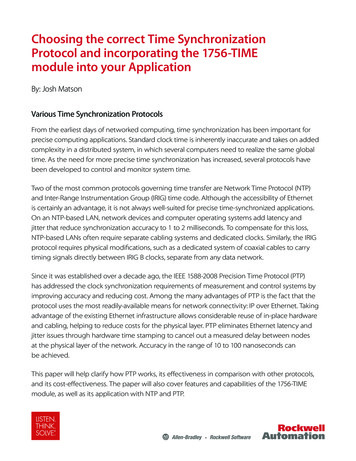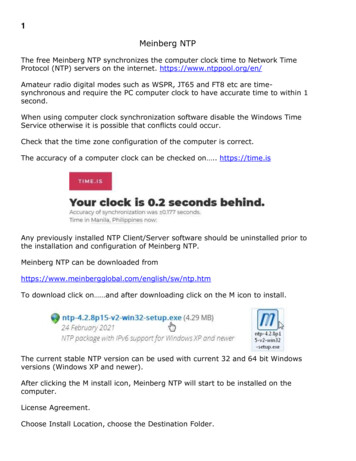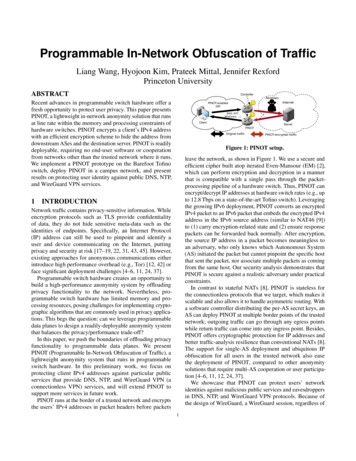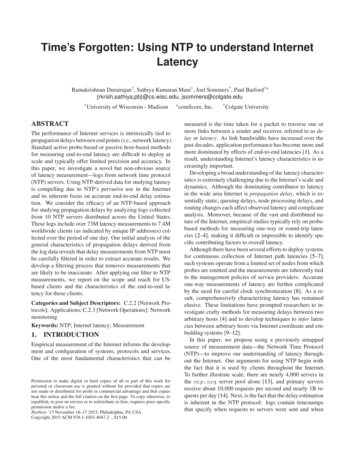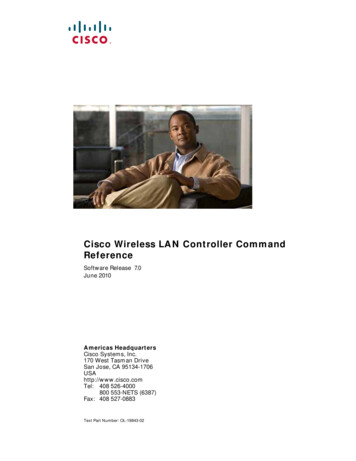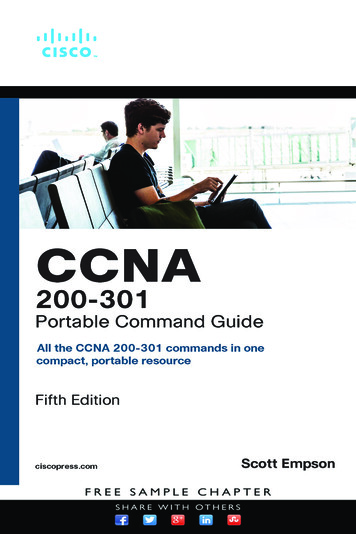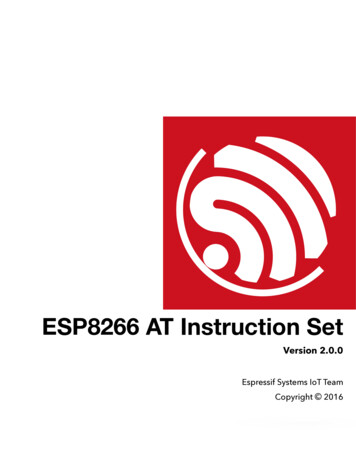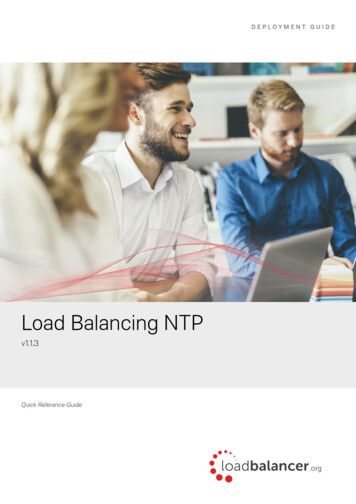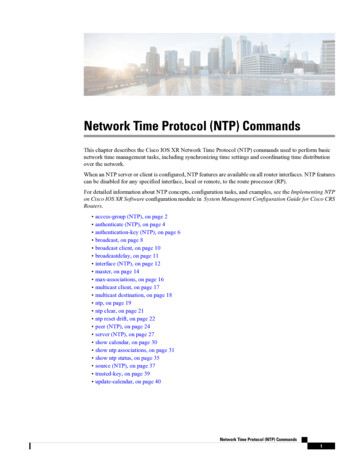
Transcription
Network Time Protocol (NTP) CommandsThis chapter describes the Cisco IOS XR Network Time Protocol (NTP) commands used to perform basicnetwork time management tasks, including synchronizing time settings and coordinating time distributionover the network.When an NTP server or client is configured, NTP features are available on all router interfaces. NTP featurescan be disabled for any specified interface, local or remote, to the route processor (RP).For detailed information about NTP concepts, configuration tasks, and examples, see the Implementing NTPon Cisco IOS XR Software configuration module in System Management Configuration Guide for Cisco CRSRouters. access-group (NTP), on page 2 authenticate (NTP), on page 4 authentication-key (NTP), on page 6 broadcast, on page 8 broadcast client, on page 10 broadcastdelay, on page 11 interface (NTP), on page 12 master, on page 14 max-associations, on page 16 multicast client, on page 17 multicast destination, on page 18 ntp, on page 19 ntp clear, on page 21 ntp reset drift, on page 22 peer (NTP), on page 24 server (NTP), on page 27 show calendar, on page 30 show ntp associations, on page 31 show ntp status, on page 35 source (NTP), on page 37 trusted-key, on page 39 update-calendar, on page 40Network Time Protocol (NTP) Commands1
Network Time Protocol (NTP) Commandsaccess-group (NTP)access-group (NTP)To control access to Network Time Protocol (NTP) services for an IPv4 or IPv6 access list, use the access-groupcommand in one of the NTP configuration modes. To remove the access-group command from theconfiguration file and restore the system to its default condition with respect to this command, use the noform of this command.access-group [vrf vrf-name] [{ipv4 ipv6}] {peer query-only serve serve-only} access-list-nameno access-group [vrf vrf-name] [{ipv4 ipv6}] {peer query-only serve serve-only}Syntax Descriptionvrf vrf-name(Optional) Applies the access control configuration to a specified nondefault VRF. If notspecified, the configuration is applied to the default VRF.ipv4(Optional) Specifies an IPv4 access list (default).ipv6(Optional) Specifies an IPv6 access list.peerAllows time requests and NTP control queries and allows a networking device tosynchronize to the remote system.query-onlyAllows only NTP control queries. Cisco IOS XR software uses NTP Version 4, but theRFC for Version 3 (RFC 1305: Network Time Protocol (Version 3)—Specification,Implementation and Analysis) still applies.serveAllows time requests and NTP control queries, but does not allow the networking deviceto synchronize to the remote system.serve-onlyAllows only time requests.access-list-name Name of an IPv4 or IPv6 access list.Command DefaultNo NTP access control is configured.Command ModesNTP configurationVRF-specific NTP configurationCommand HistoryReleaseModificationRelease 2.0This command was introduced.Release 3.8.0Support was added for: vrf vrf-name keyword and argument ipv4 keyword ipv6 keywordNetwork Time Protocol (NTP) Commands2
Network Time Protocol (NTP) Commandsaccess-group (NTP)Usage GuidelinesTo use this command, you must be in a user group associated with a task group that includes appropriate taskIDs. If the user group assignment is preventing you from using a command, contact your AAA administratorfor assistance.The access group options are scanned in the following order from least restrictive to most restrictive:1. peer—Allows time requests and NTP control queries and allows the router to synchronize itself to asystem whose address passes the access list criteria.2. serve—Allows time requests and NTP control queries, but does not allow the router to synchronize itselfto a system whose address passes the access list criteria.3. serve-only—Allows only time requests from a system whose address passes the access list criteria.4. query-only—Allows only NTP control queries from a system whose address passes the access list criteria.Access is granted for the first match that is found. If no access groups are specified, all access is granted toall sources. If any access groups are specified, only the specified access is granted. This facility providesminimal security for the time services of the system. However, it can be circumvented by a determinedprogrammer. If tighter security is desired, use the NTP authentication facility.If you use the access-group command in a VRF-specific NTP configuration mode, the command is appliedto the specific VRF. If you are not in a VRF-specific NTP configuration mode, the command is applied tothe default VRF unless you use the vrf vrf-name keyword and argument to specify a VRF.Task IDTask IDOperationsip-services read,writeThe following example shows how to configure the router to allow itself to be synchronized by apeer from an IPv4 access list named access1 and to restrict access to allow only time requests froman IPv4 access list named access2:RP/0/RP0/CPU0:router(config-ntp)# access-group peer access1RP/0/RP0/CPU0:router(config-ntp)# access-group serve-only access2The following example shows how to configure the router to allow itself to be synchronized by peersfrom the IPv6 access list named access20 that route through the vrf10 VRF:RP/0/RP0/CPU0:router(config-ntp)# access-group vrf vrf10 ipv6 peer access20Related CommandsCommandDescriptionipv4 access-listDefines an IPv4 access list by name.ipv6 access-listDefines an IPv6 access list by name.vrfConfigures a VRF instance for a routing protocol.Network Time Protocol (NTP) Commands3
Network Time Protocol (NTP) Commandsauthenticate (NTP)authenticate (NTP)To enable Network Time Protocol (NTP) authentication, use the authenticate command in NTP configurationmode. To restore the system to its default condition, use the no form of this command.authenticateno authenticateSyntax DescriptionThis command has no keywords or arguments.Command DefaultNo NTP authentication is configured.Command ModesNTP configurationCommand HistoryReleaseModificationRelease 2.0This command was introduced.Usage GuidelinesTo use this command, you must be in a user group associated with a task group that includes appropriate taskIDs. If the user group assignment is preventing you from using a command, contact your AAA administratorfor assistance.Use the authenticate command to prevent the system from synchronizing with unauthenticated andunconfigured network peers.If the authenticate command is specified, and when a symmetric active, broadcast, or multicast NTP packetis received, the system will not synchronize to the peer unless the packet carries one of the authenticationkeys specified in the trusted-key command.You must enable authenticate when enabling broadcast client or multicast client command in NTPconfiguration mode unless you have other measures (such as using the access-group command in NTPconfiguration mode) to prevent unauthorized hosts from communicating with the NTP service on the device.The authenticate command does not ensure authentication of peer associations that are created using theserver and peer commands in NTP configuration mode. When creating associations using the server andpeer commands in NTP configuration mode, specify the key keyword to ensure the authentication of packetsthat move to and from the remote peer.Use the no authenticate command to allow synchronizing with unauthenticated and unconfigured networkpeers.Task IDTask IDOperationsip-services read,writeThe following example shows how to configure the system to synchronize only to a system thatprovides an authentication key 42 in its NTP packets:RP/0/RP0/CPU0:router(config)# ntpRP/0/RP0/CPU0:router(config-ntp)# authenticateNetwork Time Protocol (NTP) Commands4
Network Time Protocol (NTP) Commandsauthenticate (NTP)RP/0/RP0/CPU0:router(config-ntp)# authentication-key 42 md5 clear key1RP/0/RP0/CPU0:router(config-ntp)# trusted-key 42Related Topicsauthentication-key (NTP), on page 6trusted-key, on page 39Network Time Protocol (NTP) Commands5
Network Time Protocol (NTP) Commandsauthentication-key (NTP)authentication-key (NTP)To define an authentication key for a trusted Network Time Protocol (NTP) time source, use theauthentication-key command in NTP configuration mode. To restore the system to its default condition, usethe no form of this command.authentication-key key-number md5 [{clear encrypted}] key-nameno authentication-key key-numberSyntax Descriptionkey-number Authentication key. A number in the range from 1 to 65535.md5Provides message authentication support using the Message Digest 5 (MD5) algorithm.clear(Optional) Specifies that the key value entered after this keyword is unencrypted.encrypted(Optional) Specifies that the key value entered after this keyword is encrypted.key-nameKey value. The maximum length is 32 characters.Command DefaultNo authentication key is defined for NTP.Command ModesNTP configurationCommand HistoryReleaseModificationRelease 2.0This command was introduced.To use this command, you must be in a user group associated with a task group that includes appropriate taskIDs. If the user group assignment is preventing you from using a command, contact your AAA administratorfor assistance.Usage GuidelinesUse the authentication-key command to define authentication keys for use with trusted NTP time sources.NoteTask IDWhen this command is written to NVRAM, the key is encrypted so that it is not displayed when theconfiguration is displayed.Task IDOperationsip-services read,writeThe following example shows how to configure the system to synchronize only to systems providingauthentication key 42 in their NTP packets:RP/0/RP0/CPU0:router(config)# ntpRP/0/RP0/CPU0:router(config-ntp)# authenticateRP/0/RP0/CPU0:router(config-ntp)# authentication-key 42 md5 clear key1Network Time Protocol (NTP) Commands6
Network Time Protocol (NTP) Commandsauthentication-key (NTP)RP/0/RP0/CPU0:router(config-ntp)# trusted-key 42Related Topicsauthenticate (NTP), on page 4peer (NTP), on page 24server (NTP), on page 27trusted-key, on page 39Network Time Protocol (NTP) Commands7
Network Time Protocol (NTP) CommandsbroadcastbroadcastTo create a Network Time Protocol (NTP) broadcast server on a specified NTP interface, use the broadcastcommand in NTP interface configuration mode. To remove the command from the configuration file andrestore the system to its default condition, use the no form of this command.broadcast [destination ip-address] [key key-id] [version number]no broadcast [destination ip-address] [key key-id] [version number]Syntax Descriptiondestination ip-address (Optional) Specifies the host IPv4 address.key key-id(Optional) Defines the authentication key, where key-id is the authentication keyto use when sending packets to this peer. The key identified by the key-id value isalso used for packets received from the peer.version number(Optional) Specifies a number from 1 to 4, indicating the NTP version.Command DefaultNo NTP broadcast servers are configured.Command ModesNTP interface configurationCommand HistoryReleaseModificationRelease 2.0This command was introduced.Usage GuidelinesTo use this command, you must be in a user group associated with a task group that includes appropriate taskIDs. If the user group assignment is preventing you from using a command, contact your AAA administratorfor assistance.Use the broadcast command to create an NTP broadcast server on an NTP interface to send NTP broadcastpackets.Use the broadcast client command to set a specific interface to receive NTP broadcast packets.Task IDTask IDOperationsip-services read,writeThe following example shows how to configure interface 0/0/0/1 to send NTP packets to destinationhost IP address 10.0.0.0:RP/0/RP0/CPU0:router(config)# ntpRP/0/RP0/CPU0:router(config-ntp)# interface tengige 0/0/0/1RP/0/RP0/CPU0:router(config-ntp-int)# broadcast destination 10.0.0.0Related Topicsbroadcast client, on page 10Network Time Protocol (NTP) Commands8
Network Time Protocol (NTP) Commandsbroadcastbroadcastdelay, on page 11Network Time Protocol (NTP) Commands9
Network Time Protocol (NTP) Commandsbroadcast clientbroadcast clientTo allow a networking device to receive Network Time Protocol (NTP) broadcast packets on an interface,use the broadcast client command in NTP interface configuration mode. To remove the configuration andrestore the system to its default condition, use the no form of this command.broadcast clientno broadcast clientSyntax DescriptionThis command has no keywords or arguments.Command DefaultNo NTP broadcast clients are configured.Command ModesNTP interface configurationCommand HistoryReleaseModificationRelease 2.0This command was introduced.Usage GuidelinesTo use this command, you must be in a user group associated with a task group that includes appropriate taskIDs. If the user group assignment is preventing you from using a command, contact your AAA administratorfor assistance.Use the broadcast client command to configure and create an NTP broadcast client and to associate the clientwith an interface to receive and handle NTP broadcast packets. If no NTP client has been created for aninterface, the received NTP broadcast packets are dropped. Use this command to allow the system to listento broadcast packets on an interface-by-interface basis.To prevent synchronization with unauthorized systems, whenever this command is specified, authenticationmust be enabled using the authenticate (NTP) command or access must be restricted to authorized systemsusing the access-group (NTP) command. See the documentation of the respective commands for moreinformation.Task IDTask IDOperationsip-services read,writeThe following example shows how to configure interface 0/0/0/1 to send NTP packets:RP/0/RP0/CPU0:router(config)# ntp interface tengige 0/0/0/1RP/0/RP0/CPU0:router(config-ntp-int)# broadcast clientRelated Topicsbroadcast, on page 8broadcastdelay, on page 11Network Time Protocol (NTP) Commands10
Network Time Protocol (NTP) CommandsbroadcastdelaybroadcastdelayTo set the estimated round-trip delay between a Network Time Protocol (NTP) client and an NTP broadcastserver, use the broadcastdelay command in NTP configuration mode. To restore the system to its defaultcondition, use the no form of this command.broadcastdelay microsecondsno broadcastdelay microsecondsSyntax Descriptionmicroseconds Estimated round-trip time for NTP broadcasts, in microseconds. The range is from 1 to999999. The default is 3000.Command Defaultmicroseconds: 3000Command ModesNTP configurationCommand HistoryReleaseModificationRelease 2.0This command was introduced.Usage GuidelinesTo use this command, you must be in a user group associated with a task group that includes appropriate taskIDs. If the user group assignment is preventing you from using a command, contact your AAA administratorfor assistance.Use the broadcastdelay command to change the default round-trip delay time on a networking device thatis configured as a broadcast client.Task IDTask IDOperationsip-services read,writeThe following example shows how to set the estimated round-trip delay between a networking deviceand the broadcast client to 5000 microseconds:RP/0/RP0/CPU0:router(config-ntp)# broadcastdelay 5000Network Time Protocol (NTP) Commands11
Network Time Protocol (NTP) Commandsinterface (NTP)interface (NTP)To enter a Network Time Protocol (NTP) interface mode and run NTP interface configuration commands,use the interface command in one of the NTP configuration modes. To remove an NTP interface configuration,use the no form of this command.interface type interface-path-id [vrf vrf-name] [disable]no interface type interface-path-id [disable]Syntax DescriptiontypeInterface type. For more information, use the question mark (?) online help function.interface-path-id Physical interface or virtual interface.NoteUse the show interfaces command to see a list of all interfaces currentlyconfigured on the router.For more information about the syntax for the router, use the question mark (?) onlinehelp function.vrf vrf-name(Optional) Applies the interface configuration to a specific nondefault VRF.disable(Optional) Disables NTP on the specified interface.Command DefaultNo NTP interfaces are configured.Command ModesNTP configuration modeVRF-specific NTP configuration modeCommand HistoryUsage GuidelinesReleaseModificationRelease 2.0This command was introduced.Release 3.8.0Support was added for the vrf keyword and the vrf-nameargument.To use this command, you must be in a user group associated with a task group that includes appropriate taskIDs. If the user group assignment is preventing you from using a command, contact your AAA administratorfor assistance.Use the interface command to place the router in NTP interface configuration mode, from which NTP broadcastand multicast servers and clients can be configured. By default, after the NTP process is started, NTP featuresbecome available for all interfaces. To exit NTP interface configuration mode, use the exit command.If you use the interface command in a VRF-specific NTP configuration mode, the command is applied to thespecific VRF. If you are not in a VRF-specific NTP configuration mode, the command is applied to the defaultVRF unless you use the vrf vrf-name keyword and argument to specify a VRF.By default, NTP is enabled on every interface. To disable NTP on a specific interface, use the interfacecommand with the disable keyword. To reenable NTP on an interface, use the no form of the interfacecommand with the disable keyword.Network Time Protocol (NTP) Commands12
Network Time Protocol (NTP) Commandsinterface (NTP)Task IDTask IDOperationsip-services read,writeThe following example shows how to enter NTP configuration mode, specify an NTP interface tobe configured, and enter NTP interface configuration mode:RP/0/RP0/CPU0:router(config)# ntpRP/0/RP0/CPU0:router(config-ntp)# interface POS 0/1/0/0RP/0/RP0/CPU0:router(config-ntp-int)#The following example shows how to enter a VRF-specific NTP interface configuration mode:RP/0/RP0/CPU0:router(config)# ntpRP/0/RP0/CPU0:router(config-ntp)# interface TenGiGE 0/1/1/0 vrf vrf 10RP/0/RP0/CPU0:router(config-ntp-int)#The following example shows a different way to enter a VRF-specific NTP interface configurationmode:RP/0/RP0/CPU0:router(config)# ntp vrf vrf 10RP/0/RP0/CPU0:router(config-ntp-vrf)# interface TenGigE k Time Protocol (NTP) Commands13
Network Time Protocol (NTP) CommandsmastermasterTo configure the router to use its own Network Time Protocol (NTP) master clock to synchronize with peerswhen an external NTP source becomes unavailable, use the master command in NTP configuration mode.To restore the system to its default condition, use the no form of this command.master [stratum]no master [stratum]Syntax Descriptionstratum (Optional) NTP stratum number that the system claims. Range is from 1 to 15. The default is8.Command DefaultBy default, the master clock function is disabled. When the function is enabled, the default stratum is 8.Command ModesNTP configurationCommand HistoryReleaseModificationRelease 2.0This command was introduced.To use this command, you must be in a user group associated with a task group that includes appropriate taskIDs. If the user group assignment is preventing you from using a command, contact your AAA administratorfor assistance.Usage GuidelinesNTP uses the concept of a “stratum” to describe how many NTP “hops” away a machine is from an authoritativetime source. A stratum 1 time server has a radio or atomic clock attached directly. A stratum 2 time serverreceives its time through NTP from a stratum 1 time server, a stratum 3 from a stratum 2, and so on.CautionUse the master command with extreme caution. It is easy to override other valid time sources using thiscommand, especially if a low-stratum number is configured. Configuring multiple machines in the samenetwork with the master command can lead to instability in time-keeping if the machines do not agree on thetime.The networking device is normally synchronized, directly or indirectly, with an external system that has aclock. Cisco IOS XR software does not support directly attached radio or atomic clocks. The master commandshould be used only when there is a temporary disruption in a reliable time service. It should not be employedas an alternative source by itself in the absence of a real-time service.If the system has the master command configured and it cannot reach any clock that has a lower stratumnumber, the system claims to be synchronized at the configured stratum number. Other systems synchronizewith it through NTP.NoteThe system clock must have been manually set from some source before the master command has an effect.This precaution protects against the distribution of erroneous time after the system is restarted.Network Time Protocol (NTP) Commands14
Network Time Protocol (NTP) CommandsmasterTask IDTask IDOperationsip-services read,writeThe following example shows how to configure a networking device as an NTP master clock towhich peers may synchronize:RP/0/RP0/CPU0:router(config)# ntpRP/0/RP0/CPU0:router(config-ntp)# master 9Network Time Protocol (NTP) Commands15
Network Time Protocol (NTP) Commandsmax-associationsmax-associationsTo set the maximum number of Network Time Protocol (NTP) associations, use the max-associationscommand in NTP configuration mode. To restore the default setting, use the no form of this command.max-associations numberno max-associations numberSyntax Descriptionnumber Maximum number of NTP associations. Range is from 0 to 4294967295. The default is 100.Command DefaultThe default setting for the maximum number of NTP associations is 100.Command ModesNTP configurationCommand HistoryReleaseModificationRelease 2.0This command was introduced.Usage GuidelinesTo use this command, you must be in a user group associated with a task group that includes appropriate taskIDs. If the user group assignment is preventing you from using a command, contact your AAA administratorfor assistance.Use the max-associations command to specify the maximum number of associations for an NTP server.Task IDTask IDOperationsip-services read,writeThe following example shows how to set the maximum number of associations to 200:RP/0/RP0/CPU0:router(config)# ntpRP/0/RP0/CPU0:router(config-ntp)# max-associations 200Related Topicsshow ntp associations, on page 31Network Time Protocol (NTP) Commands16
Network Time Protocol (NTP) Commandsmulticast clientmulticast clientTo configure an NTP interface as an NTP multicast client, use the multicast client command in NTP interfaceconfiguration mode. To remove the NTP multicast client configuration from an interface, use the no form ofthis command.multicast client [ip-address]no multicast client [ip-address]Syntax Descriptionip-address IPv4 or IPv6 IP address of the multicast group to join. The default is the IPv4 address 224.0.1.1.Command DefaultThe interface is not configured as an NTP multicast client.Command ModesNTP interface configurationCommand HistoryReleaseModificationRelease 3.8.0 This command was introduced.Usage GuidelinesTo use this command, you must be in a user group associated with a task group that includes appropriate taskIDs. If the user group assignment is preventing you from using a command, contact your AAA administratorfor assistance.Use the multicast client command to configure an NTP interface to receive multicast packets that are sent toan IPv4 or IPv6 multicast group IP address. If you do not specify an IP address, the interface is configured toreceive multicast packets sent to the IPv4 multicast group address 224.0.1.1. You can configure multiplemulticast groups on the same interface.To prevent synchronization with unauthorized systems, whenever this command is specified, authenticationmust be enabled using the authenticate (NTP) command or access must be restricted to authorized systemsusing the access-group (NTP) command. See the documentation of the respective commands for moreinformation.Task IDTask IDOperationsip-services read,writeThe following example shows how to configure the router to receive NTP multicast packets to themulticast group address of 224.0.1.1:RP/0/RP0/CPU0:router(config)# ntp interface TenGigE 0/1/1/0RP/0/RP0/CPU0:router(config-ntp-int)# multicast clientRelated Topicsmulticast destination, on page 18Network Time Protocol (NTP) Commands17
Network Time Protocol (NTP) Commandsmulticast destinationmulticast destinationTo configure an NTP interface as an NTP multicast server, use the multicast destination command in NTPinterface configuration mode. To remove the NTP multicast server configuration from an interface, use theno form of this command.multicast destination ip-address [key key-id] [ttl ttl] [version number]no multicast destination ip-address [key key-id] [ttl ttl] [version number]Syntax Descriptionip-addressThe IPv4 or IPv6 multicast group IP address to which to send NTP multicast packets.key key-id(Optional) Specifies an authentication key, where the value of the key-id argument isthe authentication key to use when sending multicast packets to the specified multicastgroup.ttl ttl(Optional) Specifies the time to live (TTL) of a multicast packet.version number(Optional) Specifies the NTP version number.Command DefaultThe interface is not configured as an NTP multicast server.Command ModesNTP interface configurationCommand HistoryReleaseModificationRelease 3.8.0 This command was introduced.Usage GuidelinesTo use this command, you must be in a user group associated with a task group that includes appropriate taskIDs. If the user group assignment is preventing you from using a command, contact your AAA administratorfor assistance.Task IDTask IDOperationsip-services read,writeThe following example shows how to configure the router to send NTP multicast packets to themulticast group address of 224.0.1.1:RP/0/RP0/CPU0:router(config)# ntp interface TenGigE 0/1/1/0RP/0/RP0/CPU0:router(config-ntp-int)# multicast destination 224.0.1.1Related Topicsmulticast client, on page 17Network Time Protocol (NTP) Commands18
Network Time Protocol (NTP) CommandsntpntpTo enter Network Time Protocol (NTP) configuration mode and run NTP configuration commands, use thentp command inglobalconfiguration mode.ntp [vrf vrf-name]Syntax Descriptionvrf vrf-name (Optional) Enters a VRF-specific NTP configuration mode.Command DefaultNo defaults behavior or valuesCommand ModesGlobal configurationCommand HistoryReleaseModificationRelease 2.0This command was introduced.Release 3.8.0Support was added for the vrf vrf-name ip-address keyword andarguments.Usage GuidelinesTo use this command, you must be in a user group associated with a task group that includes appropriate taskIDs. If the user group assignment is preventing you from using a command, contact your AAA administratorfor assistance.NTP configuration commands can also be run from global configuration mode by preceding the commandstring with the ntp keyword. From NTP configuration mode, the following NTP configuration commands areavailable:RP/0/RP0/CPU0:router(config-ntp)# eyControl NTP accessAuthenticate time sourcesAuthentication key for trusted time sourcesEstimated round-trip delayCommit the configuration changes to runningSet a command to its defaultsDescribe a command without taking real actionsRun an exec commandExit from this submodeConfigure NTP on an interfaceAct as NTP master clockSet maximum number of associationsNegate a command or set its defaultsConfigure NTP peerEnable NTP portConfigure NTP serverShow contents of configurationConfigure interface for source addressKey numbers for trusted time sourcesNetwork Time Protocol (NTP) Commands19
Network Time Protocol (NTP) Commandsntpupdate-calendarPeriodically update calendar with NTP timeUse the ntp command with the vrf vrf-name keyword and argument to enter an NTP configuration modespecific to the specified VRF.Task IDTask IDOperationsip-services read,writeThe following example shows how to enter NTP configuration mode:RP/0/RP0/CPU0:router(config)# ntpRP/0/RP0/CPU0:router(config-ntp)#The following example shows how to enter an NTP configuration mode for a VRF called VRF1:RP/0/RP0/CPU0:router(config)# ntp vrf vrf1RP/0/RP0/CPU0:router(config-ntp-vrf)#Network Time Protocol (NTP) Commands20
Network Time Protocol (NTP) Commandsntp clearntp clearTo clear all Network Time Protocol (NTP) peers or a specific NTP peer, use the ntp clear command inEXECmode.ntp clear {peer all vrf vrf-name ip-address}Syntax DescriptionpeerIPv4 address or hostname of the NTP peer to be cleared.allClears all NTP peers.vrf vrf-nameClears a peer on the specified nondefault VRF.ip-addressIPv4 or IPv6 IP address of the peer.Command DefaultNo defaults behavior or valuesCommand ModesEXECCommand HistoryReleaseModificationRelease 2.0This command was introduced.Release 3.8.0The * keyword was replaced by the all keyword.Support was added for the vrf vrf-name ip-address keyword andarguments.Usage GuidelinesTo use this command, you must be in a user group associated with a task group that includes appropriate taskIDs. If the user group assignment is preventing you from using a command, contact your AAA administratorfor assistance.Task IDTask IDOperationsip-services read,writeThe following example shows how to clear all NTP peers:RP/0/RP0/CPU0:router# ntp clear allNetwork Time Protocol (NTP) Commands21
Network Time Protocol (NTP) Commandsntp reset driftntp reset driftTo reset the NTP drift and loopfilter state, use the ntp reset drift command inEXECmode.ntp reset driftSyntax DescriptionThis command has no keywords or arguments.Command DefaultNo defaults behavior or valuesCommand ModesEXECCommand HistoryReleaseModificat
multicast destination ip-address [key key-id][ttl ttl][version number] no multicast destination ip-address [key key-id][ttl ttl][version number] SyntaxDescription ip-address TheIPv4orIPv6 multicastgroupIPaddress towhich sendNTP packets. ueofthekey-id argumentis
